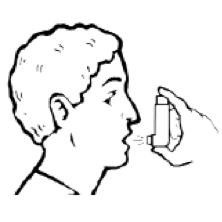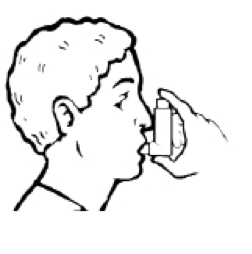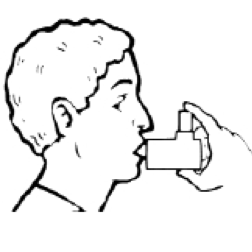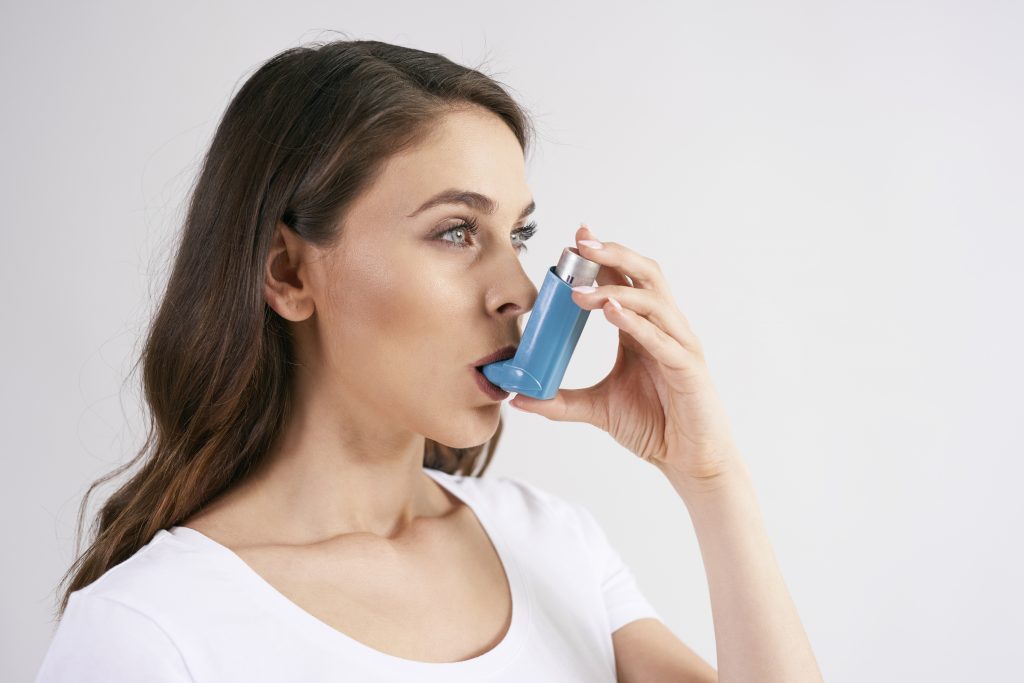Alphas with lung disease may use inhaled medicine as part of their treatment program. They use devices called inhalers to take this medicine. Metered dose inhalers (MDIs) deliver a fixed, specific dose each time you use them.
Download Inhalers – Your Options and How to Use Them as a PDF.
Spray-Type Metered Dose Inhalers (MDIs)
Spray-type MDIs consist of a pressurized canister of medicine in a plastic case with a mouthpiece. When you press the MDI, it releases a mist of medicine. Using your MDI properly ensures the most medicine makes it to your airways. Your doctor will tell you which technique is best for the medicine you’re taking.
Here’s the right way to use your spray-type MDI:
- Remove the cap from the inhaler.
- Hold the inhaler with the mouthpiece at the bottom.
- Shake the inhaler. (This mixes the medication properly.)
- Hold the mouthpiece 1-1/2 to 2 inches (2 – 3 finger widths) in front of your mouth. This helps slow the mist delivery, and ensure you only inhale small particles. Insertion all the way into the mouth makes more of the medication land in the mouth and throat, but is not wrong.


- Gently breathe out.
- Tilt your head back slightly, and open your mouth wide.
- Press the inhaler, and at the same time start breathing in slowly.
- Continue to breathe in slowly and deeply over 3 – 5 seconds.
- Hold your breath for 10 seconds. This is the most important part.
- Resume normal breathing.
- Repeat steps 3 – 10 if you’re supposed to take more than one puff.
Caring for your inhaler
It is important to keep your inhaler clean. Some products suggest using a wet cotton swab to clean the opening. Follow the instructions in your product packaging, or ask your doctor for cleaning tips.
Don’t leave your inhaler where it’s very hot or very cold. This can affect the way it works.
Using a spacer with your inhaler
Spacers help get the medicine to your airways, instead of being trapped in your mouth.

Spacers have many benefits, including:
- Less medicine is trapped in your mouth, decreasing the risk of side effects.
- It’s easier to inhale the fine mist deep into your smallest airways.
- You don’t have to coordinate the timing of the spray with your breathing.
There are a few types of spacers to choose from. You can select the one that works best for you.
Caring for your spacer
Your spacer comes with care and cleaning instructions. It’s very important to dry it after you wash it. If you leave water in your spacer, bacteria and fungi can grow. Inhaling those germs can lead to an infection. So, let your spacer dry completely after each cleaning.
Dry Powder Inhalers (DPIs)
Dry powder inhalers are becoming more common. DPIs work just as well as MDIs, and in fact, may prove to work slightly better.
As the name suggests, DPIs deliver your medicine in powder form. They’re breath activated. This means that after opening the inhaler and, in some cases, cocking it, you just breathe in quickly to start the flow of medicine. You don’t have to coordinate your breathing while you use the inhaler.
There are many types of dry powder inhalers to choose from. Each of these works a little differently.
To get the full benefit from your DPI, hold your breath for 10 seconds after taking the medicine.
Using DPIs has a few drawbacks. If you exhale directly toward the inhaler, you can blow the powdered medicine out. Also, much of the powder ends up in your mouth, which can cause unwanted side effects. To avoid side effects, rinse your mouth after using your inhaler.
Slow Mist Inhalers
Another inhaler type produces a mist that comes out slowly from the inhaler device. These are different from an MDI in the speed of medication administration. These are different than a nebulizer because all of the medication is delivered in a single spray.
The slow mist inhalers are now available for SAMA, LAMA and combination inhalers.
Nebulizers
Nebulizers deliver medicines in a fine spray or mist. Your doctor may suggest you use a nebulizer if:
- The medicine you need is only available as a liquid.
- It’s hard for you to use an inhaler correctly.
- You just prefer the nebulizer over inhalers.
No matter which device you use, the medicines will have the same positive effects. Make your choice based on what your health insurance covers and what your doctor advises.
For more in-depth information on this topic, please visit the Big Fat Reference Guide (BFRG). If you are enrolled in AlphaNet’s Subscriber Portal, you can access the BFRG here.
Download Inhalers – Your Options and How to Use Them as a PDF.

